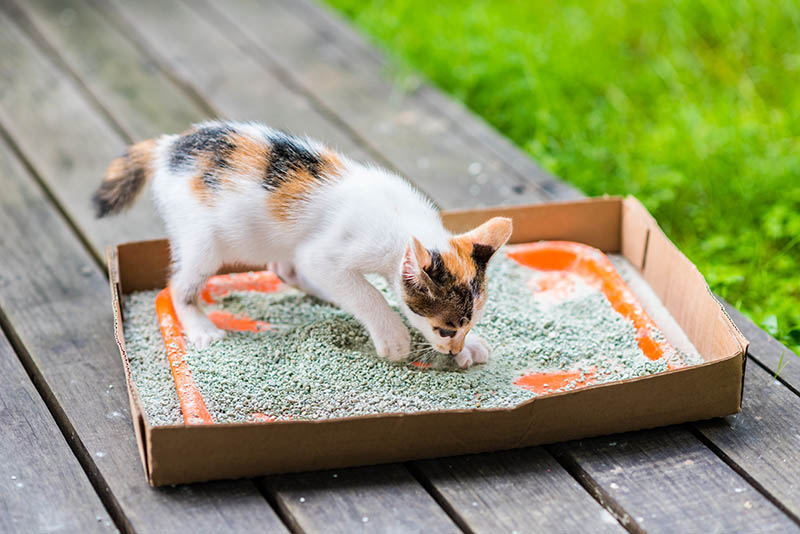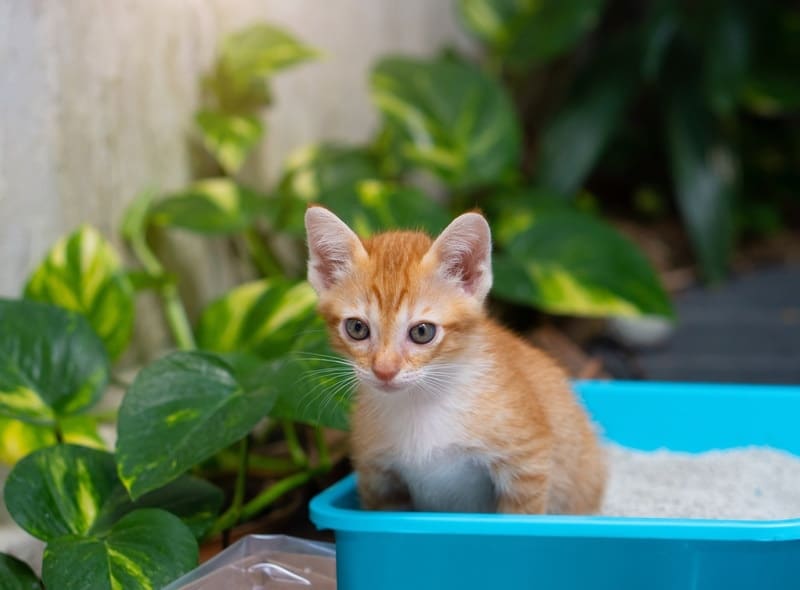Although cats are very clean animals and respond well to litter training, you might need to show them the ropes if you bring a stray cat home. While adopting a stray cat can be a rewarding experience, first ensure they do not already have an owner who is searching for them.
Stray cats are socialized with people and have lost their home, which can be for a variety of different reasons, and found themselves on the street. Many stray cats may already know how to use a litter box, but if you adopted a kitten or a cat that has been living outdoors for a while, they may need some time and training to adjust again. Stray cats may also need more patience to form a bond with their new human, depending on their previous experiences.
Stray cats, having been accustomed to the outdoors, might need guidance and patience when it comes to using a litter box, and to help you and your new furry friend out, we have put together a step-by-step guide on how to litter train a stray cat.

Before You Start
Before you start the process of litter training your stray cat, here are some tips to keep in mind:
- Never punish your cat for accidents. Accidents happen, especially with strays, and punishing them will only make them fearful of you.
- Clean up accidents promptly, or your cat will want to return to the same spot.
- Always keep your cat’s litter tray clean. Your cat doesn’t want to use the bathroom in a dirty litter box.
- Place litter boxes in areas of the house that your cat often goes to.
- Make this process as stress-free as possible for your kitty.
- Consult with your vet.
If your stray cat has frequent toileting accidents, such as missing the box or urinating or defecating outside of it, or has any issues passing urine or feces, such as straining, urinating small amounts, blood in the urine, the inability to urinate, or changes in fecal consistency, then they will need to see the vet urgently.
The 9 Tips & Tricks for Litter Training a Stray Cat
1. Choose the Right Litter Box
Choose a litter box suitable for your cat’s size and age. Large, shallow litter boxes are the best option for stray cats because they are reminiscent of their natural habitat. Consider starting with an open litter box, as some cats may feel trapped in covered ones.

2. Choose a Suitable Cat Litter
Cats can be picky about the type of litter they use. The kind of litter a cat uses can be important to them. Avoid using scented or dusty litter since they could discourage cats from using the litter box.
Try experimenting with several cat litter. Some types of litter may not absorb urine well or be as comfortable to walk on. You can try clay, crystal, paper, or wood litter.
3. Determine the Ideal Spot for the Litter Box
Put the litter box in a spot in your house that is convenient and quiet. Ensure no loud noises or other disruptions could scare the cat away from the litter box. Because we don’t want them to be seen, placing litter boxes in nooks and corners can be tempting, but it should be avoided.
Keep in mind that cats dislike feeling confined or trapped when using the bathroom. Since consistency is essential for training, avoid moving the litter box frequently and consider placing a few litter boxes to give the cat the option to choose until they show you their preferred location.
There should be at least one more litter box in your home than cats. And there needs to be three boxes if you have two cats and so on.

4. Introduce Your Cat to the Litter Box
Introduce your cat to the litter box. If you adopted a kitten, place them in the litter box after meals, playtime, or waking up. They will soon realize there is litter they can dig at and their instincts will kick in. This enables them to associate using the litter box with their natural need to eliminate. Allow them to explore and become familiar with the box at their own pace. Don’t force them to stay in the box if they want to leave.
Reward them with attention and treats after they have used the litter box. If they had an accident, place the litter box in that location to encourage them to use it instead of your floor or carpet.
If you adopted an adult stray cat, there is a good chance they already know how to use a litter box and may just need a recap.
5. Keep the Litter Boxes Clean
Your cat’s litter box should always be clean, or they will not want to use it. After each litter box visit, try to remove the waste for your kitty. To keep the depth of the litter around 2 inches after scooping, add fresh litter to provide your cat with room to dig.
When your kitten is older and routinely uses the litter box, you can scoop daily rather than every time your kitten uses the box. Replace all the litter and clean the box several times per week.
6. Positive Reinforcement
When your cat successfully uses the litter box, reward them with treats and love. Positive reinforcement helps create a positive association with the litter box, encouraging them to use it again.

7. Stay Patient and Consistent
It can take dedication and patience to litter train a stray cat, but hopefully, they have used one in their previous home or during their stay in a shelter facility . If the cat urinates outside the litter box, do not scold or punish them. Instead, carefully clean the area to eliminate any scent remnants that can encourage a recurrence a nd consult your vet, as this may actually be a sign of an underlying medical issue or stress.

If you need to speak with a vet but can’t get to one, head over to PangoVet. It’s an online service where you can talk to a vet online and get the personalized advice you need for your pet — all at an affordable price!
8. Monitor Your Cats Litter Box Use
Consult a veterinarian if your cat repeatedly refuses to eliminate it in the litter box or displays changes in toilet behaviors. Litter box aversion can be brought on by medical conditions, including urinary tract inflammation, urethral stones, crystals, infection, and more. Male cats, in particular, are at a risk of a urinary blockage, which is when their urethra gets obstructed and they cannot pee. This is a genuine emergency and needs immediate veterinary attention.


What if My Cat Won’t Use the Litter Box?
Many factors could prevent your cat from using the litter box. To rule out any underlying medical conditions, we suggest visiting your veterinarian for a check-up first. If they have given your cat a clear bill of health, then you can try these methods if your cat is having trouble learning to use the litter box and is going outside the box:
- Ensure the litter box is the right size, in the correct spot, easily accessible, and clean.
- Consider changing the litter or box type since your cat may have a preference.
- Consider scooping and replacing the litter more often.
- If you want to reduce stress and help your cat feel more at ease in their environment, consider placing pheromone diffusers close to the litter box.
- Ensure your cat is not stressed. A stressed cat is more likely to have accidents around the house.
- Be patient; litter training can take time, especially with a stray cat.
- You can always see your veterinarian for assistance in resolving your cat’s litter box concerns.
Litter training a stray cat requires patience, consistency, and understanding . By creating a comfortable and inviting environment for the cat and rewarding positive behavior, you can help your new feline companion learn to use the litter box successfully. Keep the litter box tidy, and watch for any unusual toilet behavior in your cat that will require veterinary attention . With time and patience, your stray cat will become a well-trained and happy member of your household . Featured Image Credit: pkproject, Shutterstock
Conclusion
Contents
- Before You Start
- The 9 Tips & Tricks for Litter Training a Stray Cat
- 1. Choose the Right Litter Box
- 2. Choose a Suitable Cat Litter
- 3. Determine the Ideal Spot for the Litter Box
- 4. Introduce Your Cat to the Litter Box
- 5. Keep the Litter Boxes Clean
- 6. Positive Reinforcement
- 7. Stay Patient and Consistent
- 8. Monitor Your Cats Litter Box Use
- What if My Cat Won’t Use the Litter Box?
- Conclusion









